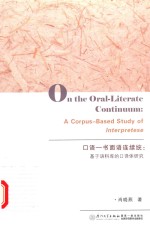图书介绍
口语-书面语连续统 基于语料库的口译体研究【2025|PDF|Epub|mobi|kindle电子书版本百度云盘下载】

- 肖晓燕著 著
- 出版社: 厦门:厦门大学出版社
- ISBN:9787561556184
- 出版时间:2015
- 标注页数:287页
- 文件大小:19MB
- 文件页数:304页
- 主题词:口译-研究
PDF下载
下载说明
口语-书面语连续统 基于语料库的口译体研究PDF格式电子书版下载
下载的文件为RAR压缩包。需要使用解压软件进行解压得到PDF格式图书。建议使用BT下载工具Free Download Manager进行下载,简称FDM(免费,没有广告,支持多平台)。本站资源全部打包为BT种子。所以需要使用专业的BT下载软件进行下载。如BitComet qBittorrent uTorrent等BT下载工具。迅雷目前由于本站不是热门资源。不推荐使用!后期资源热门了。安装了迅雷也可以迅雷进行下载!
(文件页数 要大于 标注页数,上中下等多册电子书除外)
注意:本站所有压缩包均有解压码: 点击下载压缩包解压工具
图书目录
Chapter 1 Introduction2
1.1 Research Background2
1.1.1 The Primacy of Spoken Discourse2
1.1.2 The Study of Translatese4
1.1.3 Interpretese as Spoken and Translated Discourse6
1.1.4 The Oral-Literate Continuum8
1.2 Aims of the Study9
1.3 Significance of the Study11
1.4 Methodology and Data14
1.4.1 Methodology14
1.4.2 Data Selection15
1.4.3 Data Preparation18
1.4.4 Data Description21
1.5 Structure of the Thesis21
1.6 Terminology23
Chapter 2 Literature Review25
2.1 The Study of Language as Discourse25
2.2 The Study of Spoken Discourse29
2.2.1 Reawakening to the Primacy of Spoken Discourse29
2.2.2 Spoken Discourse vs.Written Discourse31
2.2.3 Orality vs.Literacy35
2.3 Genre and Register37
2.4 Corpus-Based Translation Studies40
2.4.1 Impact of Corpus Linguistics40
2.4.2 From“Equivalence”to“Norms”41
2.4.3 Translatese and Translation Universals42
2.4.4 The Study of Translatese in China46
2.5 Corpus-Based Interpreting Studies47
2.5.1 Challenges of Corpus-Based Interpreting Studies48
2.5.2 Headways in Corpus-Based Interpreting Studies49
2.5.3 Shlesinger's Work on Interpretese51
2.5.4 Study on Interpretese in China52
2.6 Evaluation of Previous Research54
2.6.1 Inadequate Study of Interpretese as Spoken Discourse54
2.6.2 Weakness in the Study of Interpretese as Translated Discourse55
2.6.3 Issues with Chinese-English Interpreting Corpus58
2.6.4 Methodological Issues of Studying Chinese-English Interpretese59
Chapter 3 Theorectical Framework60
3.1 G&RT as Conceptual Framework60
3.1.1 Definition of Genre60
3.1.2 Types and Functions of Genre62
3.1.3 Differentiating Genre and Register64
3.2 The MD Approach as Methodological Framework66
3.2.1 The Dimensions66
3.2.2 MD as a Macroscopic Approach69
3.2.3 MD as a Microscopic Approach70
3.2.4 MD as Quantitative and Qualitative Method71
Chapter 4 Interpretese as a Genre74
4.1 Defining Interpretese74
4.1.1 Interpreting vs.Translating75
4.1.2 I nterpretese Defined79
4.1.3 Is Interpretese a Genre?80
4.2 Describing Interpretese as a Genre83
4.2.1 Modality84
4.2.2 Ontology85
4.2.3 Registers86
4.3 Interpretese on the Oral-Literate Continuum90
4.3.1 Zellermayer's Shifts on the Continuum90
4.3.2 Shlesinger's Parameters of Orality92
4.3.3 Biber's Dimensions of Orality97
4.3.4 Measuring Orality:An Integrated Model99
4.3.5 Modifying the Model for Chinese111
Chapter 5 An MD Analysis of Interpretese114
5.1 The Corpus114
5.1.1 Strengths of the Current Corpus114
5.1.2 Describing the Corpus118
5.2 Selection of Linguistic Features119
5.2.1 Dimension A:Involvedness122
5.2.2 Dimension B:Constrainedness126
5.2.3 Dimension C:Context-Boundedness127
5.2.4 Dimension D:Abstractness132
5.2.5 Dimension E:Prosody133
5.3 Frequency Counts and Analysis135
5.3.1 Dimension A135
5.3.2 Dimension B144
5.3.3 Dimension C153
5.3.4 Dimension D160
5.3.5 Dimension E163
5.4 Gender as a Variable169
5.4.1 Male Speakers vs.Female Speakers169
5.4.2 Male Interpreters vs.Female Interpreters171
5.5 Language Status as a Variable174
5.5.1 English A Speakers vs.English B speakers175
5.5.2 English A Interpreter vs.English B Interpreters177
5.5.3 Chinese A Interpreters vs.Chinese B Interpreter178
5.6 Factor Analysis180
5.6.1 Why Factor Analysis?180
5.6.2 Explaining Loadings181
5.6.3 Identifying Factors181
5.7 Interpreting the Data186
Chapter 6 On the Oral-Literate Continum:Panel Discussions vs.Other Registers186
6.1 Panel Discussion as a Register188
6.2 Panel Discussions vs.Other Registers190
6.2.1 Along the Continuum of Involvedness191
6.2.2 Along the Continuum of Constrainedness197
6.2.3 Along the Continuum of Context-Boundedness200
6.2.4 Along the Continuum of Abstractness204
6.2.5 A Multidimensional Description of Registers205
Chapter 7 Conclusion208
7.1 Findings from the Current Investigation208
7.2 Significance and Implications213
7.3 Limitations and Future Research215
References217
Appendices242
Appendix 1 A sample of E-ST242
Appendix 2 A sample of E-TT250
Appendix 3 A sample of C-ST262
Appendix 4 A sample of C-TT266
Acknowledgements287
热门推荐
- 564805.html
- 2946624.html
- 669927.html
- 3274951.html
- 3610242.html
- 1469085.html
- 2342299.html
- 499943.html
- 2469254.html
- 771586.html
- http://www.ickdjs.cc/book_615246.html
- http://www.ickdjs.cc/book_613006.html
- http://www.ickdjs.cc/book_2715286.html
- http://www.ickdjs.cc/book_478818.html
- http://www.ickdjs.cc/book_3705413.html
- http://www.ickdjs.cc/book_915143.html
- http://www.ickdjs.cc/book_3577433.html
- http://www.ickdjs.cc/book_2093815.html
- http://www.ickdjs.cc/book_1629095.html
- http://www.ickdjs.cc/book_2685549.html